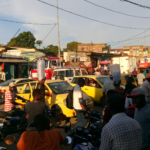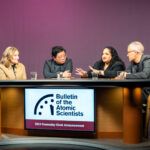Nagasaki — 71 years later
By Bulletin Staff | August 9, 2016
Today, 71 years later, the world remembers one of the most lethal bomb attacks in world history. In the immediate aftermath of the atomic blast at Nagasaki, anywhere from 45,000 to 75,000 lives were lost.
In many ways, Nagasaki is a more realistic – and thus alarming – case study of what a modern nuclear strike might look like. Hiroshima was considered an ideal military target: a medium-size population center that had been untouched by conventional weapons with a sizable troop concentration. Nagasaki, on the other hand, had no major troop concentration. It did have the Mitsubishi industrial complex, but the main reason it was chosen as the target that day was because the primary target – Kyushu – had poor visibility. Nagasaki’s hilly geography, unsuited for a nuclear strike but suitable for surviving one, accounted for the minor difference in the loss of life between the two blasts.
Today, 71 years later, the world remembers one of the most lethal bomb attacks in world history. In the immediate aftermath of the atomic blast at Nagasaki, anywhere from 45,000 to 75,000 lives were lost.
In many ways, Nagasaki is a more realistic – and thus alarming – case study of what a modern nuclear strike might look like. Hiroshima was considered an ideal military target: a medium-size population center that had been untouched by conventional weapons with a sizable troop concentration. Nagasaki, on the other hand, had no major troop concentration. It did have the Mitsubishi industrial complex, but the main reason it was chosen as the target that day was because the primary target – Kokura – had poor visibility. Nagasaki’s hilly geography, unsuited for a nuclear strike but suitable for surviving one, accounted for the minor difference in the loss of life between the two blasts.
If Hiroshima was bombed to prove there was a nuclear weapon, Nagasaki was bombed to prove there were more. In this way, Nagasaki encapsulates the horrifying reality of a nuclear-armed world and the false narrative of the ideal first strike.
Please take a look at our special collection of articles commemorating the 71st anniversary of the only atomic bombings in history.

Six Weeks after Nagasaki, by John Mecklin
A mother’s love, after Hiroshima, by Kathleen Burkinshaw
Why the United States did not demonstrate the Bomb's power, ahead of Hiroshima, by Frank von Hippel and Fumihiko Yohida
Let Hiroshima guide us back to nuclear basics, by Kennette Benedict
Obama, Hiroshima, apologies and the invisible victims of the atomic bombings, by Tessa Morris-Suzuki
What President Obama should say at Hiroshima, by Hugh Gusterson
Hiroshima and the Iran agreement, by Rachel Bronson
Hiroshima and Nagasaki: Lessons learned? Development and Disarmament roundtable, by Akira Kawasaki, Mustafa Kibaroglu, and Suvrat Raju
The harrowing story of the Nagasaki bombing mission, by Ellen Bradbury and Sandra Blakeslee
Related Reading:
What would happen if an 800-kiloton nuclear warhead detonated above midtown Manhattan? by Steven Starr, Lynn Eden, Theodore A. Postal
Confronting plutonium nationalism in Northeast Asia, by Fumihiko Yoshida
Nuclear Notebook Interactive: Our infographic on the world’s nuclear arsenals
Together, we make the world safer.
The Bulletin elevates expert voices above the noise. But as an independent nonprofit organization, our operations depend on the support of readers like you. Help us continue to deliver quality journalism that holds leaders accountable. Your support of our work at any level is important. In return, we promise our coverage will be understandable, influential, vigilant, solution-oriented, and fair-minded. Together we can make a difference.















